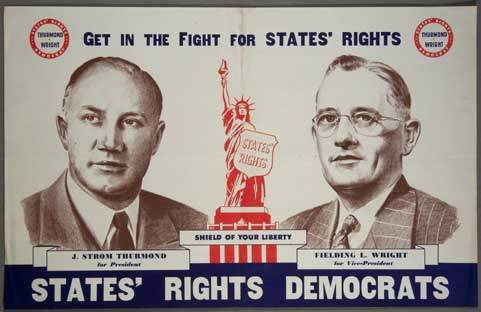
The infiltration of Marxist ideology into the high-echelons of federal government can be back-dated to the 1930s and FDR’s administration. Russian-born revolutionary Sidney Hillman provided communist votes for FDR in his earlier run for governor of New York, FDR appointed him labor advisor after becoming president in 1932. By 1936, Hillman had created the communist-dominated Congress of Industrial Organizations (CIO, later merged with the AFL) as well as the first political action committee, the CIO-PAC. The PAC funneled labor union money to FDR’s reelection campaign as well as attracting socialist and communist votes. Hubert Humphrey idolized FDR and rose to vice-president under LBJ. To understand why Southern Democrats formed the Dixiecrat party in 1948, look no further than the communist domination of the Democrat party by the mid-1940s.
Bernhard Thuersam
Minnesota Progressives and Liberals, Circa 1945:
“In creating the Democratic-Farmer-Labor Party, Humphrey had permitted Communists and extreme leftists to gain control of the party’s nerve center. In winning the mayorship [of Minneapolis] in 1945, he vigorously courted the pro-Communist elements that virtually controlled the State’s CIO labor federation. For nearly two more years Mayor Humphrey cultivated the backing of pro-Communist radicals until events impelled him to take them on in a political life and death struggle.
Following his election in 1945 he was quick to ingratiate himself with the radical elements that controlled the State’s CIO. The CIO’s pro-communist Minnesota Labor, for example, reported that close to 700 progressives and liberals of Minnesota” packed the main ballroom of the [Radisson] hotel to honor” the fellow-travelling Elmer Benson at a testimonial dinner in August, 1945. Among those at the head table: Mayor Hubert Humphrey.
In November, Mayor Humphrey, attending the annual CIO convention in Minneapolis, addressed the CIO’s Political Action Committee along with Benson and Stalinist William Mauseth, then CIO-PAC director. The resolutions and rhetoric that flowed from the gathering could have been scripted in the Kremlin.
The convention passed a resolution urging all unions to wage an “unrelenting struggle against the evils and dangers of….group discrimination that go hand-in-hand with labor-baiting.” Such heavy-handed epithets, of course, were usually hurled by Communists and leftist propagandists at anyone who opposed the progressive paradise in the Soviet Union and/or the excessive demands of Communist-dominated unions in the United States.
Minnesota Labor reported Humphrey as “strongly endorsing” the CIO’s eight-point [socialist] program before Congress though it is not absolutely clear whether he embraced it entirely [or] necessarily reveal his willingness to curry favor with the extreme left-wing of the United States, for liberals, radicals and Communists have historically found themselves pushing for similar domestic programs.
The acid test of whether a person cultivated the Communist line was whether he also endorsed a foreign policy which coincided with the aims of the Soviet Union. Humphrey did.
[It] is quite likely that [Humphrey] sympathized with CIO policy, judging from his pro-Soviet speech in January….[and] he approved of the Soviet conquest of the Baltic states, endorsed the thought that Stalin should ensure the establishment of “friendly” governments on the Soviet borders, and justified Russia’s “absorption” of its neighboring states. Furthermore, it is clear that Humphrey found himself in agreement with another resolution adopted by the convention: having America withdraw its support from Chiang Kai-shek. The [communist Chinese] reviled Chiang because he was pro-West and militantly anti-communist.
In vigorously urging the United States to take steps which would mean the abandonment of China to the Communists, Humphrey was doing the bidding of the pro-Communist CIO-PAC in Minnesota.”
(Hubert, An Unauthorized Biography of the Vice President, Allan H. Ryskind, Arlington House, 1968, pp. 95-101)

No comments:
Post a Comment